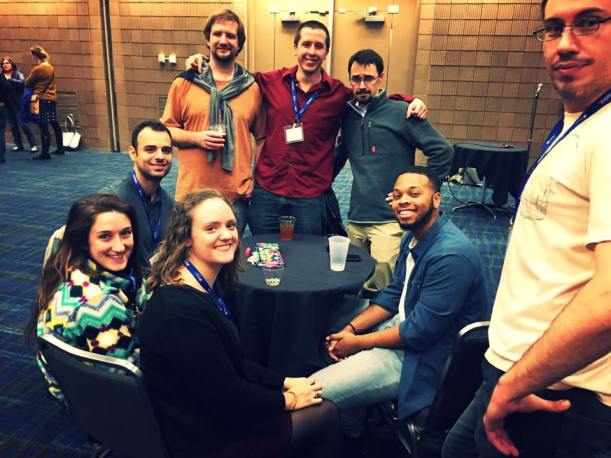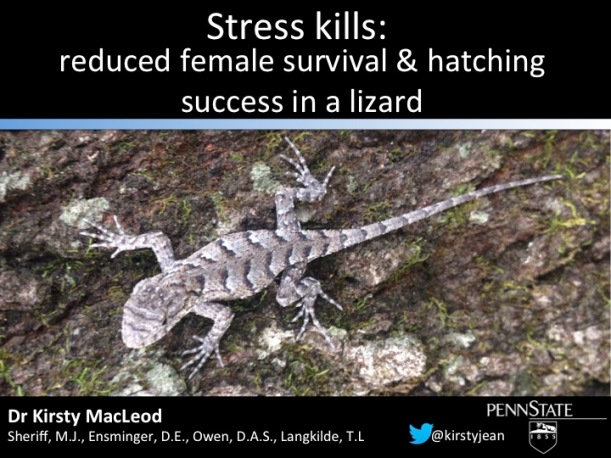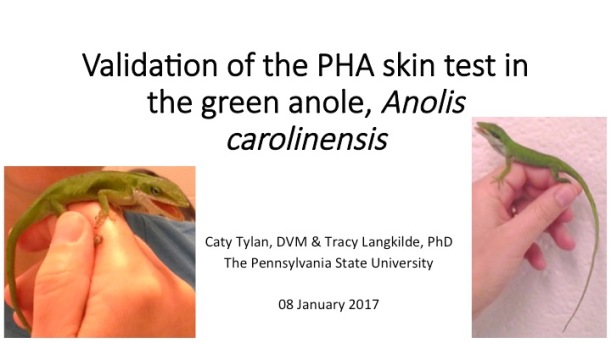The Langkilde lab has recently returned from its annual pilgrimage to the SICB (Society for Integrative and Comparative Biology) meeting, which this year was held in beautiful New Orleans! All our lab members presented talks, and had a great time networking, catching up on top research, and telling people about our own.
Below are some of our thoughts on the meeting, summaries of what we presented – and some tips for conference-goers from all fields!

Langkilde lab members past and present reunited at SICB (photo: Cate Pritchard)

Beautiful New Orleans (photo: Kirsty MacLeod)

Cam and Tracy hang out at the Data Blitz (photo: Cate Pritchard)
Kirsty MacLeod
“I talked about a paper I’ve been working on from our field season in Alabama last summer. Animals encounter environmental stressors daily; how does frequent, low-level stress influence survival and reproductive success? We show that, in Eastern fence lizards, a daily dose of low-concentration stress hormone led to increased adult mortality, and decreased hatching success of her eggs. This was the first conference I’ve been to where animal behaviour hasn’t been the primary focus – this reflects my broadening interests – I’m really excited by integrative research, so this meeting was a great way to see what other people are doing in more mechanistic fields (physiology, genetics, etc). It gave me lots of ideas for taking my own work forward!
My top conference tips are to contact people in advance that you want to talk to – that way you’ll be less likely to chicken out of approaching them! And – make use of Twitter before, during, and after the conference. It’s a great, informal networking tool. I met up with loads of top researchers that I’d first contacted on Twitter, and made lots of new friends!”

David Ensminger
“I presented on the impact of a stress treatment on maternal behavior and offspring physiology and morphology. The thing I enjoyed the most was getting to meet not only senior researchers but also new researchers and hearing both of their perspectives.
My tip is to go to the socials and groups at night. They are fantastic places to talk with and meet people.”

Cam Venable
“We already know fire ants are an invasive predator to many organisms, including fence lizards. What I want to focus on is the interaction of Fence Lizards and Fire ants, but as a prey source. This is the first step in my research, by using this study system, to understand how native species adapt to invasive species. The academic side of me really enjoyed meeting other scientist and just chitchatting in informal ways. The 24 year old side of me loved the location of SICB, considering it was in New Orleans!
Tips for conferences: Well this was my very first conference and I was worried about how to interact with so many bright and accomplished minds. The best and most cliché bit of advice I have, is simply be you. There is no point in putting on a different face, if you’re not even comfortable in it.”

“The water chemistry of vernal pools are often impacted by the environment. Changes in the pH and UVB impact the larval amphibians that live there. But how? Stay tuned for an upcoming publication! I LOVED meeting new people. I especially enjoyed meeting people who are working outside of my field of study. Their perspectives on my work are often very different than those within my field and I learn a lot from them.
My advice: TALK TO EVERYONE! You never know who you will meet. If you see a poster you don’t usually have an interest in, just stop and ask a question. If nothing else you may make a friend!”

“Going to SICB for the first time was fantastic, and New Orleans is a peculiar, very musical city, which I appreciated a lot. Being exposed to research from large variety of fields in biology certainly allowed me to appreciate other research areas better, so I definitely recommend attending talks that are out of your comfort zone. You never know what new ideas you might come up with!
Another valuable tip I have is, to never underestimate the power of a 25-minute nap during lunch break. The amount of information you receive over multiple days in a conference can be a bit overwhelming, so it’s important to rest whenever possible. It also helps you enjoy the nightlife better!”


Tracy Langkilde
Many of you would have played with Mexican Jumping Beans as a child. Ever wondered why it is that they jump? I presented some undergraduate-led research revealing what motivates this fascinating behavior.





